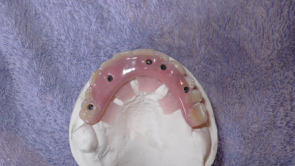Dental Implant
Complications
Dental implant complications are the things that CAN happen during dental implant treatment that we DON'T WANT TO HAPPEN!
One of the most common dental implant complication is some degree of nerve damage in the area of the dental implant.
On the one hand, this could be as simple as a slight tingling on the side of your tongue after implant surgery. It feels like mild "pins and needles" in the side of your tongue or perhaps on the edge of your lip. This sort of thing will usually get better on its own within a few months.
At the other extreme, it could be a complete numbness of your lower lip and part of your chin, on the side where the implant was done. You don't have any sensation at all; you can't feel hot or cold, touch, nor even a pinprick.
Again, this usually slowly gets better without any treatment over 6 to 12 months. But sometimes (rarely) the numbness is permanent.
Read more about numb tongue complications HERE.
The next possibility is that the dental implant does not end up exactly where the dentist intended it to be. If an implant is being put into the upper jaw to replace a back tooth, it is possible for the implant to slip into the "sinus"; This is an air cavity under each cheek bone. I have seen this happen on one occasion; the implant worked its way out a few days later when the patient blew his nose!
He came in to the office and handed the boss an envelope. The boss thought it was a letter from a lawyer! But when he opened it he found the wayward implant. True story. The surgical site in his mouth healed up normally, and the implant was re-done a few months later.
Dental Implant Complications
In some cases, everything goes according to plan, but the area around the implant is very slow to heal.
It stays red and inflamed for longer than normal.The only solution here is time, and keeping the area as clean as possible.
The best way to keep the area clear of food debris and prevent a build-up of bacteria is by using an efficient sonic toothbrush that has a very gentle high-frequency vibration. I'd recommend the Cybersonic 3 toothbrush.
Slow healing is more likely to happen if you have certain medical conditions like diabetes, or if you smoke. There is also slower healing if you have ever had a type of medication called bisphosphonates, for osteoporosis. Your dentist should have checked all this beforehand, and warned you of the possible complications.
A final factor is how well you look after yourself and your new implant.
You should not smoke.
You should avoid the implant area as much as possible, and not poke it with your finger or keep putting your tongue there.
If you have a removable denture, it's best to leave it out for a few days after surgery. A removable denture can irritate the gum tissue by moving slightly, rubbing on the gum over the implant; it can also attract dental plaque bacteria, which may cause inflammation in the gum tissues.
Most complications can be avoided with thorough planning by your dentist and the skill of an experienced implant surgeon. A CT scan ("Computerised Tomograph") should be done as part of the initial implant planning, BEFORE any treatment.
This gives your dentist a 3-D image of your jaws, so he can see where there is sufficient bone to get an implant to fit.
 CT scanner
CT scannerDental Implant Complications
After the dental implant has been put in, and the gum has healed, and your new tooth (or teeth) has been fitted, you might think that's the end of the story.
Not quite.
There are a few additional complications that may crop up over time.
The first of these is your new tooth becoming slightly wobbly. You will feel it moving slightly when you eat, and when you wiggle it with your fingers, you will see the small movement.
There are 2 possible dental implant complications here;
First possibility; the dental implant in your jawbone may be fine, BUT the tiny screw that holds your new tooth (crown or cap) to the implant has worked loose. Don't worry, all you have to do is go back to your dentist. He will remove the crown and the screw, check for damage, sterilize everything and then re-fit the crown onto your implant with either a new screw or the existing one, if it's undamaged.
Second possibility, the crown may be securely screwed (or cemented) to your dental implant, BUT the implant itself has become loose. When this happens after 12 months or more, it's called a "late failure". For some reason, the bone healing against the implant surface has broken down, and the implant has lost its secure anchor. Once it starts to move, it will never become secure again. The implant has failed. It must be removed, and done over again.
The second complication after 12 months is called "peri-implantitis". This is a redness and inflammation of the gum around the neck of the implant. It is almost always caused by plaque collecting just under the gum edge, where it touches the implant.
Once this inflammation gets started, it can be difficult and time-consuming to fix. And it's important to fix it, otherwise the bacteria involved can get under the gum into the bone holding the implant in place. That will result in the implant eventually working loose.
The best way to treat peri-implantitis is to get an oral irrigator (like a tiny jet-wash for your teeth), and instead of putting water in the tank, use an anti-plaque mouthwash.
This will help to remove the plaque and settle the gum down when it's become puffy and sore. After the swelling has settled down, you will need to start using an ultrasonic toothbrush, to get the plaque deposits off that accumulate each day. I recommend the Cybersonic3 toothbrush, because it's very efficient at removing plaque, but also gentle on the sensitive gums.
Once the gum has settled enough to brush, you should have a new DAILY routine!
- First, brush gently with the Cybersonic3 brush.
- Second, go around the problem area with the oral irrigator to flush out any scraps of plaque that the brush has dislodged but possibly left behind.
These recommendations will treat peri-implantitis before it gets serious, and keep it from coming back if you follow my instructions.
SO FAR, we have talked about dental implant complications that affect the dental implant itself - how the implant is anchored into your jawbone, and how the gum around the implant may react.
BUT there are possible complications to do with the tooth or teeth that are fitted to the implants. This usually involves chipping, cracking or even fracture of the acrylic or ceramic that has been used to build up the teeth.
 bridge held by screws
bridge held by screwsIf the tooth or teeth have been fitted to your dental implants with screws, then it is relatively simple for your dentist to remove the chipped or broken tooth/teeth, and get it repaired.
But if the teeth have been cemented to the implant, it's a bit more tricky to get out so that it can be repaired.
Of course, sometimes (rarely), it is not possible to repair the problem, and you will need to get a new tooth or teeth made in the dental lab. Your dentist is the best person to make that decision.
Dental implant complications DO occur from time to time, in spite of meticulous planning. Your dentist should warn you about these possible complications before you have the implant surgery, and get you to sign a form stating that you give informed consent for the treatment.



